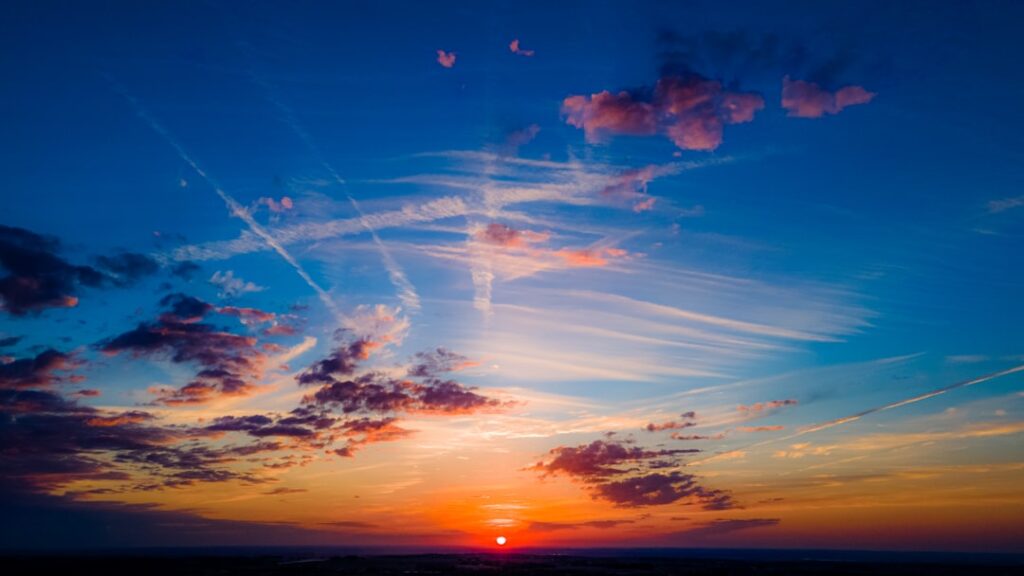Blue clouds are a fascinating and beautiful natural phenomenon that has captured the imagination of people for centuries. These unique clouds, which appear in various shades of blue, can be seen in different parts of the world and are a sight to behold. The mesmerizing beauty of blue clouds has inspired artists, poets, and scientists alike, and their presence in the sky never fails to evoke a sense of wonder and awe.
Blue clouds are formed when light is scattered by small particles or molecules in the Earth’s atmosphere. This scattering of light causes the shorter blue wavelengths to be scattered more than the longer red wavelengths, resulting in the appearance of blue clouds. The science behind blue clouds is complex and fascinating, and understanding the processes that lead to their formation can help us appreciate their beauty even more.
Key Takeaways
- Blue clouds are a fascinating natural phenomenon that have captured the interest of scientists, artists, and photographers alike.
- The science behind blue clouds involves the scattering of light by small particles in the atmosphere, resulting in the unique blue coloration.
- Different types of blue clouds include noctilucent clouds, cirrus clouds, and thunderclouds, each with their own distinct characteristics.
- Blue clouds can have both positive and negative impacts on the environment, from reflecting sunlight and cooling the Earth to contributing to air pollution and climate change.
- Capturing the beauty of blue clouds through photography allows us to appreciate their ephemeral and ever-changing nature, while art and culture have long been inspired by the mystique of blue clouds. Protecting and preserving the beauty of blue clouds is essential for future generations to enjoy and study.
The Science Behind Blue Clouds
The science behind blue clouds is rooted in the principles of light scattering and the composition of the Earth’s atmosphere. When sunlight enters the Earth’s atmosphere, it is made up of different colors, each with a different wavelength. The shorter blue wavelengths are scattered more by the small particles and molecules in the atmosphere, causing the sky to appear blue during the day. When these same principles are applied to clouds, the result is the formation of blue clouds.
Blue clouds can also be formed as a result of specific atmospheric conditions, such as the presence of ice crystals or water droplets of a certain size. These particles can scatter light in such a way that the clouds appear blue to the human eye. Additionally, certain types of clouds, such as cirrus clouds, are more likely to appear blue due to their high altitude and composition. Understanding the science behind blue clouds can help us appreciate the intricate processes that occur in the Earth’s atmosphere and the stunning visual effects they produce.
Different Types of Blue Clouds
There are several different types of blue clouds that can be observed in the sky, each with its own unique characteristics and formation processes. One of the most common types of blue clouds is cirrus clouds, which are thin and wispy clouds found at high altitudes. These clouds are composed of ice crystals and are known for their delicate appearance and tendency to appear blue in certain lighting conditions.
Another type of blue cloud is altocumulus clouds, which are mid-level clouds that often appear in patches or layers. These clouds can take on a bluish hue when viewed from certain angles, adding a touch of color and drama to the sky. Additionally, lenticular clouds, which form in mountainous regions, can also exhibit shades of blue under the right conditions.
Understanding the different types of blue clouds and their unique characteristics can enhance our appreciation for the diversity and beauty of these natural phenomena. Whether it’s the ethereal beauty of cirrus clouds or the dramatic presence of altocumulus clouds, each type of blue cloud adds its own special touch to the canvas of the sky.
The Impact of Blue Clouds on the Environment
| Impact Factor | Measurement |
|---|---|
| Temperature | Decrease in local temperature due to reflection of sunlight |
| Precipitation | Potential decrease in rainfall due to altered cloud properties |
| Ecology | Impact on plant and animal life due to changes in sunlight and rainfall |
| Atmospheric Chemistry | Potential impact on chemical reactions and air quality |
Blue clouds not only captivate our senses with their beauty but also play a significant role in the Earth’s climate and environment. The presence of blue clouds can affect the amount of sunlight reaching the Earth’s surface, which in turn impacts temperature and weather patterns. Additionally, certain types of blue clouds, such as cirrus clouds, can contribute to the greenhouse effect by trapping heat in the atmosphere.
Furthermore, blue clouds can also have an impact on precipitation patterns and water cycles, influencing the distribution of rainfall and snowfall in different regions. Understanding the environmental impact of blue clouds is crucial for gaining insights into their role in shaping our planet’s climate and weather systems.
Capturing the Beauty of Blue Clouds through Photography
Photography provides a powerful medium for capturing the breathtaking beauty of blue clouds and preserving these fleeting moments for posterity. Whether it’s a vibrant sunset casting a warm glow on a blanket of blue clouds or a stormy sky filled with dramatic shades of blue, photographers have long been drawn to the allure of capturing these natural wonders through their lenses.
Photographing blue clouds requires an understanding of light, composition, and timing to truly capture their essence. The interplay of light and shadow on the textured surface of clouds can create stunning visual effects that evoke a sense of wonder and awe. From wide-angle landscape shots to close-up details of cloud formations, photography allows us to appreciate the intricate details and ever-changing nature of blue clouds.
Blue Clouds in Art and Culture

Blue clouds have been a source of inspiration for artists and creators throughout history, appearing in paintings, literature, music, and other forms of artistic expression. The ethereal beauty and symbolic significance of blue clouds have been woven into cultural narratives and artistic interpretations, reflecting their enduring impact on human imagination and creativity.
In art, blue clouds have been depicted in various styles and mediums, from classical landscape paintings to abstract interpretations that capture their emotional essence. The symbolism of blue clouds as a representation of freedom, spirituality, or transcendence has been explored by artists across different cultures and time periods, adding layers of meaning to their visual representation.
Protecting and Preserving the Beauty of Blue Clouds
As we continue to appreciate the beauty and significance of blue clouds, it is essential to consider their conservation and preservation in the face of environmental challenges. Climate change, air pollution, and other human activities can have a detrimental impact on the Earth’s atmosphere and cloud formations, potentially altering their appearance and behavior.
Protecting the beauty of blue clouds requires collective efforts to reduce carbon emissions, preserve natural habitats, and promote sustainable practices that minimize harm to the environment. By raising awareness about the importance of preserving our planet’s natural wonders, including blue clouds, we can contribute to safeguarding these awe-inspiring phenomena for future generations to enjoy.
In conclusion, blue clouds are a captivating natural spectacle that continues to inspire wonder and fascination. From their scientific origins to their artistic interpretations, blue clouds hold a special place in our collective imagination and cultural heritage. By understanding their significance and taking steps to protect their beauty, we can ensure that future generations will have the opportunity to marvel at the mesmerizing sight of blue clouds dancing across the sky.
If you’re interested in learning more about the phenomenon of blue clouds, you should check out this article on artcandiecoin.com. The article discusses the science behind the formation of these rare and beautiful clouds, as well as their significance in weather patterns and climate change. It’s a fascinating read for anyone curious about the natural world and atmospheric phenomena.
FAQs
What are blue clouds?
Blue clouds are a rare atmospheric phenomenon that occurs when ice crystals in the clouds are of a certain size and shape, scattering sunlight in a way that makes the clouds appear blue.
What causes blue clouds?
Blue clouds are caused by the scattering of sunlight by ice crystals in the clouds. The ice crystals must be of a specific size and shape to scatter the sunlight in a way that makes the clouds appear blue.
Where can blue clouds be seen?
Blue clouds can be seen in various parts of the world, but they are most commonly observed in polar regions such as the Arctic and Antarctic.
Are blue clouds dangerous?
Blue clouds are not dangerous and do not pose any threat to human health or safety. They are simply a natural atmospheric phenomenon.
Can blue clouds be predicted?
Blue clouds are difficult to predict, as they depend on specific atmospheric conditions and the size and shape of ice crystals in the clouds. They are considered a rare and unpredictable phenomenon.


